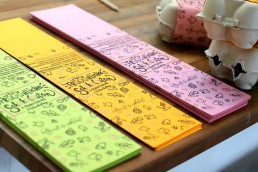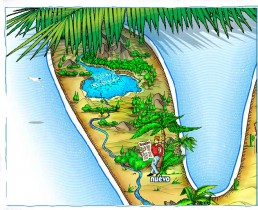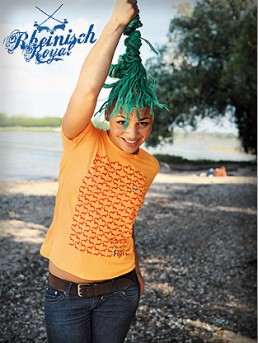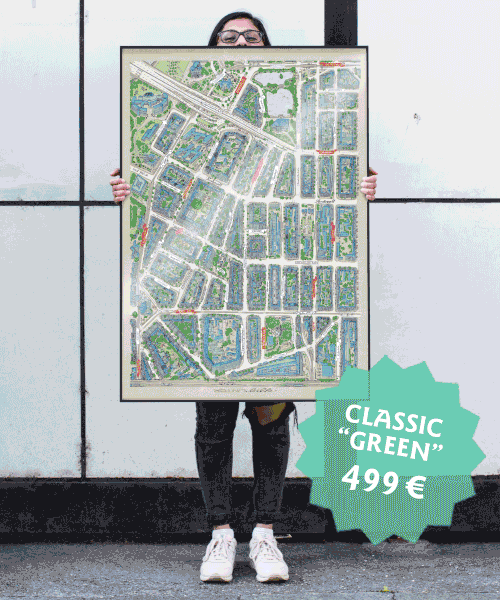Hanfdruck unter Palmen
Sieht aus wie ein alter dicker Retrofotokopierer ist aber unser neuster Risograph!
Die Risographie ist ein Schablonendruckverfahren (wie Siebdruck) und dabei noch ziemlich öko: die Farben sind auf Soja-Basis und die Masterschablonen, die für jeden Druck erzeugt werden, aus biologisch abbaubaren Hanffasern.
Für jede Farbe benötigt man einen eigenen Druckzylinder, was pro Farbe einen Druckdurchgang mit in der Maschine getauschten Zylindern erfordert. Also pro Farbe einen Zylinder. Wir haben uns bisher fünf Farben gegönnt: Schwarz, Grün, Rot, Gelb, Weiß und Gold, sparen aber für weitere, also gerne fleißig unsere Bilder aus dem Onlineshop kaufen, damit wir mehr Spielgeld haben :-)
Wer also unsere Risographen mal ausprobieren möchte, schöne Einladung- oder Hochzeitskarten, Etiketten oder ähnliches zu gestalten und/oder zu drucken hat, bitte gerne melden, wir sparen für die nächsten Farben!!!
Ganz lieben Dank übrigens auch noch mal an Kat von Bittersüß und Edelweiss auf der Lorettostrasse, die sich als "Versuchskaninchen" für Ihre Schokolostern-Etiketten zur Verfügung gestellt hat!
Es gab einmal eine Insel im Internet
Falls Ihr noch Flash auf Eurem Rechner installiert habt, laden wir Euch ein, unser altes buenasoma island zu besuchen, wir bringen es einfach nicht übers Herz, sie in den Fluten modernen Daten-Overloads ertrinken zu lassen ... (oh man, ist das 2005, alles Liebe an Pablo, Alex und Sebastian!!! ;-))
Hier gehts auf die Insel: www.buenasoma.com/retro-island
Übrigens wer sich jetzt fragt, warum die Insel einem X-Chromosom nachempfunden ist, fragt uns am besten persönlich, das führt hier jetzt zu weit!
Rheinisch Royal ...
... HEIMISCH LOYAL: LOCAL GREEN COUTURE!
Unser rheinisches T-Shirt-Label: Rheinisch Royal möchte mit einem Teil des Erlöses die rheinische Subkultur fördern. Neben dem regionalen Aspekt setzt Rheinisch Royal auf Green Couture: Produkte werden fair gehandelt und immer mehr sind aus Biobaumwolle hergestellt, ohne Verwendung mineralölbasierender Kunstdünger, Pestizide oder Herbizide. Zu schön, um wahr zu sein? Man kann es auch kaufen: www.rheinischroyal.de
Und für alle Zwischen-, Weiter- und Einzelhändler die Rheinisch Royal vertreiben oder einfach nur mitmachen möchten: Meldet Euch & spread the message!
Beitrag 1
If you’re not sure how much time you are actually spending on various tasks, use a tool like Rescue Time (their free version is excellent!) which runs in the background and tracks where your time is being spent. It can even send you weekly reports so you know exactly how much time you wasted on Facebook, or spent in your email inbox! You can assign different websites or programs/applications on a scale of very distracting to very productive, so you can see at a glance things like: which days of the week you’re most productive, which times of the day you’re most productive, and the sites on which you’re spending the most distracting time. I stumbled upon the concept of margin while reading a post by Michael Hyatt, which led me to design my ideal week.
Richard Swenson, M.D. (who wrote the book: Margin: Restoring Emotional, Physical, Financial, and Time Reserves to Overloaded Lives) describes margin like this:
Last year I wrote about why booking too far in advance can be dangerous for your business, and this concept of margin so eloquently captures what I had recognized had been my problem: I was so booked up with clients that I wasn’t leaving any margin for error, growth, planning, or reflection. I wasn’t really growing my business in a sustainable way; I was just booking one client after the next. At the time this seemed like a good thing: doesn’t growing my business mean getting more clients?
What if instead of booking up to 100% capacity (which more often than not ends up being closer to 120%), we only booked up to an 80% capacity?
What if we left more room for growth (personal or professional) and stopped being one with “busy-ness”?
I spent nearly a year turning down every new project (and even getting rid of old ones) so that I could reduce my workload, build in more margin, and create what is now Digital Strategy School. It takes time to build margin into your schedule.
What could you accomplish with 20% more time?
Write a book. Create a program. Update your contracts and proposals (which has been on your to-do list for how long..?) Spend more time with your family. Go above and beyond for a client. Learn something new. Actually follow through on the things that have been nagging at you for a long time.
When you design your ideal week, you start to see that the time you think you have is often not in alignment with how much time you actually have.
After designing my ideal week, I had a much clearer idea of how to create a framework for my week that would empower me to feel more focused by theming days of the week, and even parts of the day. SO simple, I know. Some of you have been doing this for ages and you’re already a pro, and some of you who saw my schedule said “woah, that’s so rigid, I need more flexibility!”
Structure enables flexibility.
If you’re not sure how much time you are actually spending on various tasks, use a tool like Rescue Time (their free version is excellent!) which runs in the background and tracks where your time is being spent. It can even send you weekly reports so you know exactly how much time you wasted on Facebook, or spent in your email inbox! You can assign different websites or programs/applications on a scale of very distracting to very productive, so you can see at a glance things like: which days of the week you’re most productive, which times of the day you’re most productive, and the sites on which you’re spending the most distracting time. Turns out I’m consistently “in the zone” around 3pm in the afternoon; so instead of trying to tackle highly creative work first thing in the morning (when my brain is barely functioning), I handle it in the afternoon, when I know I’m at my peak!
Creating more margin has been game-changing for my business.
What would be possible for yours?




